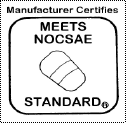 For those of you with children playing soccer in high school or college, new shinguard standards go into effect this Fall. The standard from the NOCSAE stipulates that all shinguards must be tested annually and have a readily visible certification seal that indicates they passed lab testing and indicate the height of the tallest player that size shinguard is appropriate for.
For those of you with children playing soccer in high school or college, new shinguard standards go into effect this Fall. The standard from the NOCSAE stipulates that all shinguards must be tested annually and have a readily visible certification seal that indicates they passed lab testing and indicate the height of the tallest player that size shinguard is appropriate for.
All too often players are wearing very small shinguards, exposing them to serious injury. The initial standard required the seal be visible on the front of the guard for referee inspection, however recent modifications allow for tags to be sewn into the top of the shinguard.
One issue being raised by parents is that many online vendors still don’t indicate if the guards for sale have this seal, and what the height range is for each. Also, there is some variance between manufacturers where a “L” shin-guard from one may be in the same height range as an “XL” from another. So if you are in the market for new shinguards, or you have an older player on a high school or collegiate team, you’ll need to make sure their shinguards are NOCSAE certified and are the appropriate size for their height.
I haven’t heard of any state youth associations mandating these standards yet, but it seems like a very good idea. Those of you who administer youth leagues should strongly consider informing your parents this summer about the proper size shinguard to purchase for their child, as many have no idea. Now that the NOCSAE labels will have the proper height information on them, it will be easier for parents to judge which size to buy.I’d say most youth associations should mandate certified shinguards as well, but to phase it in over two years or so. Use those two years to let everyone know about the proper size to get, and in two years, everyone should already be getting the right guards for their kids.
Note this standard was originally supposed to go into effect last Fall, but they delayed it a year to give the manufacturers more time to get their product lines updated and tested.
A few people are concerned about players who tape their guards to hold them in place, which seems to have been addressed according to the SGMA:
Provisions have been made in the standard for guards that are held in position by tape, a sock or other type of accessory item. For details of these provisions please review the most recent version of the standard available at the NOCSAE website.
But I cannot find any reference to tape in the standard. They may be referring to the change allowing the seal to be on tags sewn into the top back of a guard (which can be flipped out for referees to see), but it’s not clear.
So keep this in mind if you go to buy shin guards this season, even if your child is younger – it’s a good standard to adhere to!
H/T LegalEagle





January 20th, 2010 at 6:20 pm
What happens if the shin guards do not have a standard or are the wrong size? Either they meet standard or they dont.
For that matter we should exclude people who use uncertified or wrong-sized shin guards from the pitch since we have even less assurance that they are tested. I used to use old newspapers and never had a problem.